Small Space Gardening: Balcony Ideas with Containers & Vertical Planters
This page may contains affiliate links. We may earn a commission for purchases made at no additional cost to you. The content on this website was created with the help of AI.
Ever stared at your tiny balcony or limited outdoor space, feeling that familiar pang of garden envy when scrolling through lush backyard paradises on Instagram? You’re not alone. Many of us urban dwellers have resigned ourselves to the belief that meaningful gardening requires sprawling yards and endless sunshine. But what if I told you that your modest balcony, narrow patio, or even that neglected sunny windowsill has the potential to become a thriving green sanctuary?
Small space gardening isn’t just a compromise—it’s an exciting opportunity to get creative with vertical solutions, clever containers, and strategic planning. With the right approach, even the tiniest balcony can yield a surprising abundance of herbs, vegetables, and flowers that transform your space while nourishing both body and spirit. Whether you’re a complete beginner nervously eyeing your first plant or someone looking to maximize every square inch of your urban oasis, the techniques and ideas we’ll explore together will help you cultivate the garden you’ve been dreaming of—no backyard required.
Vertical Gardening: Growing Up When You Can’t Grow Out
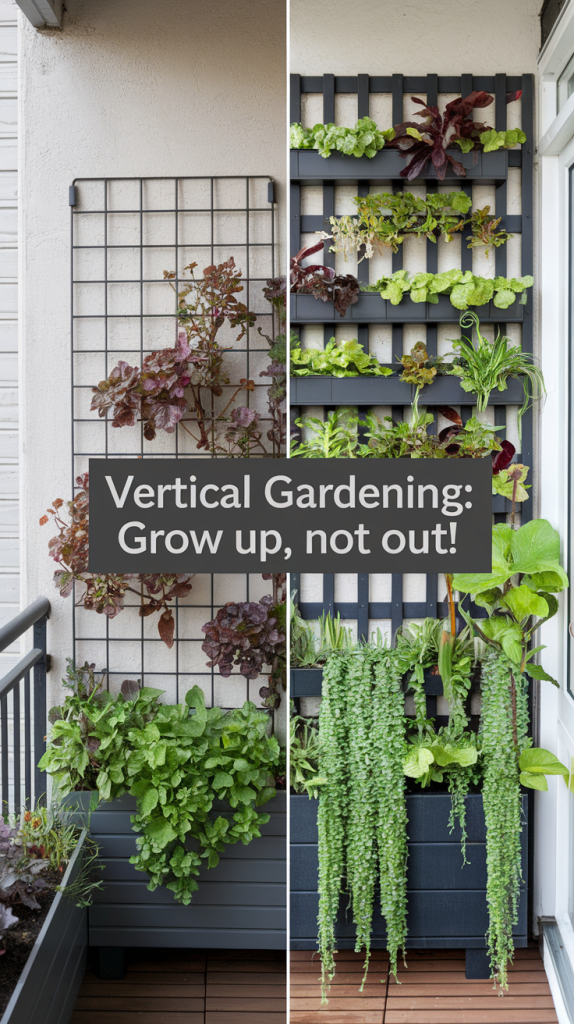
When horizontal space is at a premium, the obvious solution is to reach for the skies. Vertical gardening transforms walls, railings, and other upright spaces into productive growing areas, effectively multiplying your gardening real estate without expanding your footprint.
Start by assessing your vertical opportunities—balcony walls, railings, fences, or even strategically placed standalone structures. Each offers different mounting options and weight considerations. For rental properties where permanent installation isn’t possible, freestanding trellises or tension rod systems can provide vertical space without damaging walls.
Pocket planters offer one of the simplest entry points to vertical gardening. These fabric organizers—similar to shoe storage—create multiple planting compartments on a single hanging unit. Fill each pocket with herbs, strawberries, or trailing flowers for an instant living wall. Ensure you select shallow-rooted plants appropriate for the limited soil volume of each pocket.
Trellis systems work wonderfully for vining vegetables and flowering climbers. A simple grid attached to your balcony wall can support sugar snap peas, cucumbers, or decorative sweet peas that grow upward rather than outward. For beginners, start with forgiving climbers like nasturtiums or pole beans that enthusiastically scale almost any support.
Don’t overlook the potential of repurposed items for vertical structures. An old wooden ladder creates charming plant shelving, while coat racks can become unique hanging gardens when S-hooks and lightweight pots are added. These upcycled solutions add personality while serving practical growing needs.
Picture this: A previously bare balcony wall transformed into a living tapestry of cascading herbs and compact vegetables. Mint and thyme spill from upper pockets while cherry tomatoes ripen along a central trellis. Every inch of vertical space contributes to your harvest while creating a lush green backdrop for your outdoor seating area.
Explore versatile vertical gardening systems that make growing upward simple and efficient.
Container Selection: Beyond Basic Terracotta
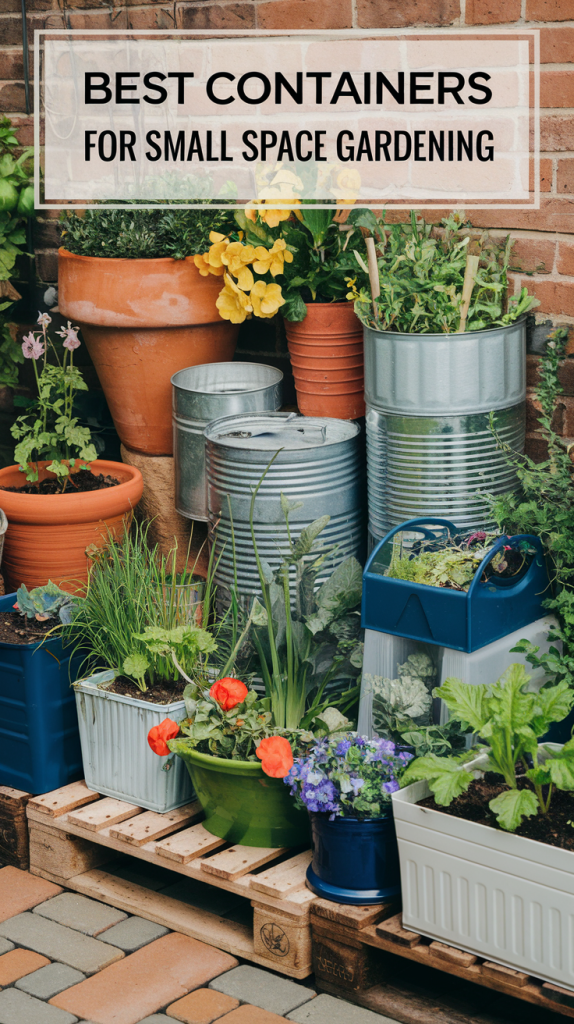
Containers form the foundation of small space gardening, but their impact extends far beyond simple functionality. Strategic container selection influences not just plant health but also your garden’s aesthetic, maintenance needs, and space efficiency.
When choosing containers, consider weight restrictions first—especially for balconies with structural limitations. Fiberglass and plastic containers offer lightweight alternatives to traditional ceramics while still providing good insulation for root systems. For extremely weight-conscious situations, fabric grow bags present an ultra-lightweight option with the added benefits of excellent drainage and air pruning of roots.
Size matters significantly in small space gardening. Rather than filling your area with numerous tiny pots that dry out quickly and limit root growth, opt for fewer, larger containers that create visual impact while providing adequate soil volume. A strategic collection of differently sized containers creates visual interest while accommodating various plant needs.
Self-watering containers revolutionize balcony gardening by extending the time between watering sessions—perfect for busy gardeners or hot exposures. These clever planters incorporate water reservoirs that plant roots can access as needed, reducing stress from irregular watering while conserving precious water.
Don’t overlook the creative potential of repurposed containers. Vintage wooden crates lined with landscape fabric make charming herb gardens, while colanders and metal buckets with drainage holes add industrial charm. These unconventional choices often become conversation pieces while giving new life to old items.
Picture this: A balcony corner adorned with a curated collection of containers at varying heights—a large self-watering planter bursting with colorful Swiss chard and compact bush beans anchors the space, while surrounding metal buckets in gradual size progression hold aromatic herbs, creating a functional kitchen garden that doubles as an artistic installation.
Discover lightweight self-watering containers that make balcony gardening more manageable.
Coconut Shell Creativity: Sustainable Micro-Containers
Nature provides some of the most charming and eco-friendly planting vessels, with coconut shells standing out as particularly versatile micro-containers for small space gardens. These natural bowls offer an organic aesthetic while providing excellent growing conditions for many plants.
Preparing coconut shells requires minimal effort for maximum impact. After consuming the coconut meat and water, thoroughly clean the interior and drill several drainage holes in the bottom. For longevity, consider lightly sanding the exterior and applying a thin coat of linseed oil, which preserves the shell without introducing harmful chemicals near your plants.
Coconut shells excel as containers for moisture-loving smaller plants. Their natural fiber composition regulates humidity while the shell’s curved shape cradles delicate root systems. Suitable plants include air plants, succulents, miniature African violets, and small herbs like thyme or mint that won’t outgrow the limited space quickly.
Create visual interest by mounting coconut shell planters at different heights. Sturdy hemp or macramé hangers transform individual shells into hanging features, while groupings arranged on shelving create natural vignettes. The shells’ organic appearance works particularly well in bohemian or tropical-themed garden spaces.
For an elevated presentation, consider adding decorative elements to your coconut planters. Woodburned patterns, natural twine wrapping, or even simple painted accents can customize these natural vessels to complement your overall garden aesthetic while maintaining their eco-friendly appeal.
Picture this: A sunny balcony corner featuring a collection of coconut shell planters suspended at varying heights by simple macramé hangers. Each shell cradles a different cascading succulent or compact herb, their textural foliage contrasting beautifully with the rustic brown shells. Sunlight filtering through the arrangement creates a dynamic play of shadows across your balcony floor.
Explore eco-friendly gardening supplies to complement your sustainable coconut shell containers.
Balcony Layout: Maximizing Limited Square Footage
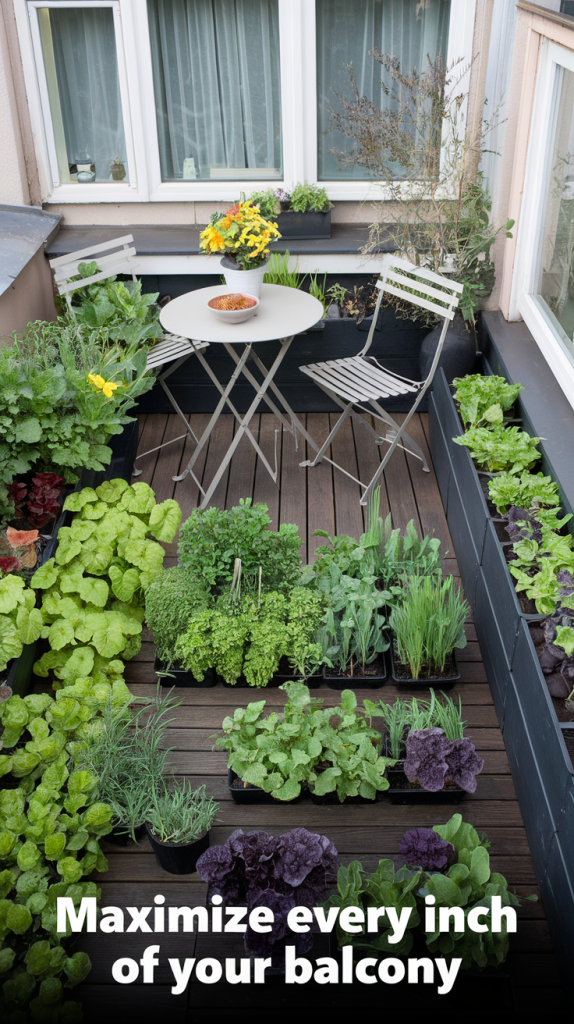
A thoughtfully designed layout transforms even the most compact balcony into a functional growing space without sacrificing comfort or circulation. The key lies in strategic planning that addresses both horizontal and vertical planes while considering practical usage patterns.
Begin by mapping your balcony’s microclimates—areas of full sun, partial shade, and deep shade dictate what can thrive in each zone. Track sunlight patterns throughout the day before placing containers, as urban settings often create unusual light conditions that change seasonally. This environmental awareness prevents frustrating plant failures caused by mismatching species to conditions.
Implement the “thriller, filler, spiller” approach in your container arrangements to maximize visual impact while economizing space. Each grouping includes a tall focal plant (thriller), mid-height plants that add fullness (filler), and trailing varieties that cascade over edges (spiller). This three-dimensional planting strategy creates lush abundance without requiring additional footprint.
Consider traffic patterns in your layout planning. Leave clear pathways for comfortable movement, especially to frequently accessed areas like seating or doors. Hanging planters and rail-mounted containers preserve floor space while still contributing to your garden, making even the smallest balconies navigable.
Incorporate multi-functional elements wherever possible. A narrow potting bench with shelving above serves as both workspace and vertical growing area, while a storage bench might feature a living roof of sedum or herbs. These dual-purpose additions maximize utility without compromising your growing space.
Picture this: A 4’x8′ balcony transformed through strategic zoning—a compact bistro set occupies one corner beneath hanging herb baskets, while the sunny railing supports a row of productive vegetable containers. A narrow shelving unit against the wall creates multiple growing tiers in the shade zone, while clear pathways maintain easy access to all areas. Despite its small footprint, every zone contributes to both beauty and harvest.
Find space-saving balcony furniture that complements your garden layout.
Plant Selection: Varieties That Thrive in Confined Spaces
The secret to small space gardening success often lies in choosing the right plant varieties specifically bred for container performance. These compact powerhouses deliver full-sized flavors and beauty without demanding extensive space.
For edible gardens, focus on “dwarf,” “bush,” or “patio” varieties explicitly developed for container growing. Bush cucumber varieties like ‘Spacemaster’ produce full-sized cucumbers on compact vines, while determinate tomatoes like ‘Tiny Tim’ or ‘Balcony’ deliver impressive harvests without overwhelming small spaces. These specialized varieties offer all the production of their larger cousins without the sprawling growth habits.
Consider “cut-and-come-again” vegetables that provide multiple harvests from a single planting. Leafy greens like loose-leaf lettuce, spinach, and swiss chard can be harvested repeatedly by taking only outer leaves while allowing the center to continue growing. This approach maximizes production from limited space while ensuring continuous harvests.
Vertical performers deserve special attention in tight quarters. Look for vining plants with strong climbing instincts—sugar snap peas, scarlet runner beans, and indeterminate tomatoes (with proper support)—that eagerly grow upward when provided with trellises or strings. These vertical producers convert wall space into productive growing area.
Don’t overlook dual-purpose plants that contribute both beauty and utility. Rainbow chard offers ornamental value alongside culinary uses, while edible flowers like nasturtiums provide vibrant color, unique flavors, and cascading growth habits perfect for container edges. These multitaskers maximize the return on your limited space investment.
Picture this: A single large container showcasing a perfect partnership of plants—a central ‘Patio Princess’ tomato plant provides the thriller element with its upright growth and cherry-sized fruits, surrounded by purple basil as the aromatic filler, while oregano cascades over the edges as the flavorful spiller. This thoughtful combination creates a visually stunning “pizza garden” that occupies minimal space while delivering maximum culinary potential.
Discover seeds specially bred for container gardening that thrive in confined areas.
Vertical DIY Projects: Handcrafted Space-Saving Solutions
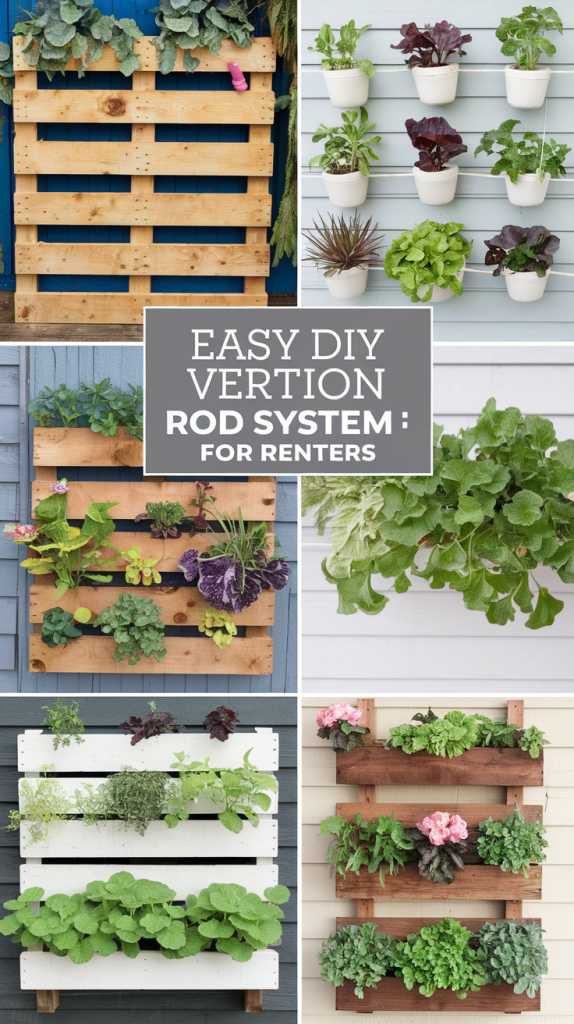
Creating your own vertical gardening systems allows for customization perfectly suited to your unique space constraints while often costing significantly less than commercial options. These DIY projects range from simple afternoon tasks to more involved weekend endeavors.
The gutter garden offers one of the simplest yet most effective DIY solutions for narrow balconies. Vinyl rain gutters mounted to walls or railings create lightweight growing channels perfect for shallow-rooted plants like lettuce, strawberries, and herbs. Ensure proper drainage by drilling holes every few inches and sloping the gutters slightly to prevent waterlogging.
Pallet gardens transform reclaimed wooden shipping pallets into dramatic vertical growing walls. After securing the pallet’s back and sides with landscape fabric to create planting pockets, these structures can support dozens of plants in a remarkably small footprint. Select untreated pallets for food crops to avoid potential chemical contamination.
For apartment dwellers needing temporary solutions, tension rod plant stations offer innovative growing space without permanent installation. Similar to shower curtain setups, adjustable rods pressed between floors and ceilings create sturdy mounting points for lightweight hanging containers. This approach proves particularly valuable for renters prohibited from drilling into walls or ceilings.
Repurpose everyday items for unique vertical elements. An old wooden ladder becomes tiered plant shelving when positioned against a wall, while a pegboard mounted securely offers infinite arrangements of hanging pots that can evolve with your gardening needs. These character-rich solutions add personality while maximizing growing space.
Picture this: A previously unused narrow balcony wall now supporting a living tapestry created from a transformed wooden pallet. Each slat-created pocket bursts with strawberry plants, their bright red fruits dangling at eye level for easy harvesting. Cascading herbs fill the lower pockets while compact lettuces occupy the upper sections, their varying textures and colors creating a functional art piece that transforms your limited outdoor space.
Find essential tools for DIY garden projects perfectly sized for small space work.
Water-Wise Techniques: Efficient Irrigation for Containers
Container gardens typically require more frequent watering than in-ground plantings, but innovative irrigation approaches can dramatically reduce this maintenance burden while conserving precious water resources.
Self-watering systems create water reservoirs that plants can access as needed, dramatically extending the time between manual waterings. Commercial self-watering containers incorporate built-in reservoirs, but DIY versions can be created using plastic bottles, wicking cords, and recycled containers at minimal cost. These systems prove particularly valuable during heat waves or travel periods.
Ollas—unglazed clay vessels buried in container soil—provide an ancient yet effective irrigation solution. Fill these porous containers with water, which then slowly seeps into surrounding soil as plants require moisture. This targeted hydration delivers water directly to root zones with minimal evaporation loss, perfect for drought-prone balconies.
Grouping containers creates beneficial microclimates that reduce water loss. Plants transpire moisture that benefits their neighbors, while the reduced exposure of pot sides lowers evaporation rates. This community approach not only conserves water but also increases humidity around your plants—particularly beneficial in dry urban environments.
Mulching remains as crucial in containers as in traditional gardens. A layer of organic material like cocoa hulls, small bark chips, or even decorative pebbles significantly reduces evaporation while regulating soil temperature. In small containers, even a half-inch layer makes a measurable difference in water retention.
Picture this: A self-sufficient container garden that requires watering just once weekly, even during summer heat. Recycled wine bottles converted to self-watering reservoirs deliver consistent moisture to tomato plants, while clusters of herbs in mulched containers create humidity pockets that benefit their neighbors. A central terra cotta olla keeps mixed salad greens hydrated with minimal intervention, allowing you to enjoy your garden rather than constantly maintaining it.
Discover water-efficient irrigation systems designed specifically for container gardens.
Four-Season Interest: Balcony Gardens Beyond Summer
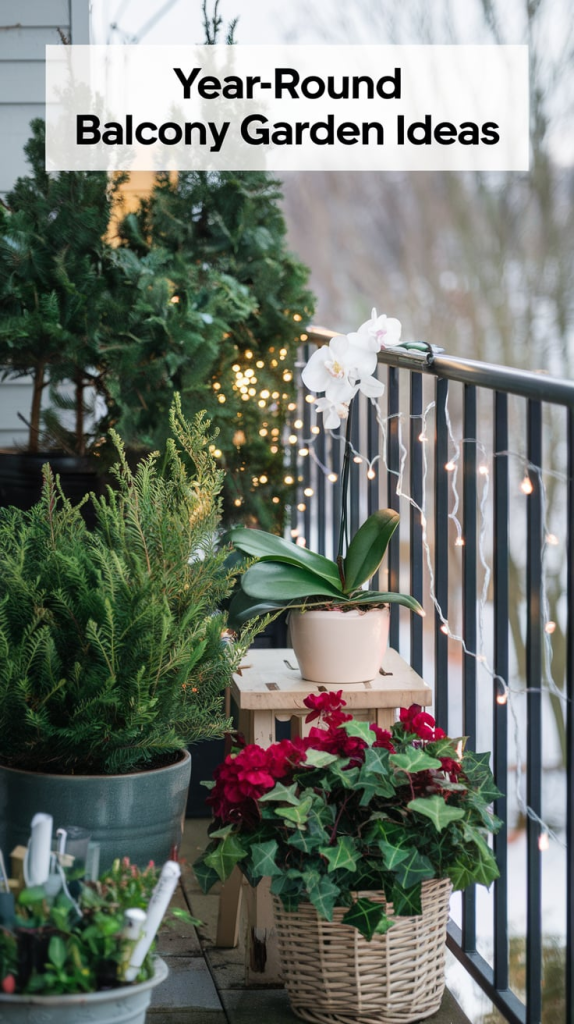
A truly successful small space garden evolves with the seasons, providing year-round interest through thoughtful planning and strategic plant selection. This perpetual garden approach ensures your outdoor space remains vibrant regardless of weather conditions.
Plan for succession planting by preparing a simple calendar of what grows when in your specific climate. As spring crops like peas and lettuce finish, summer performers like tomatoes and basil can take their place. When these fade, autumn brings opportunities for cool-season greens and root vegetables. This choreographed approach ensures continuous production from the same containers throughout the growing season.
Incorporate structural elements that maintain visual interest during dormant periods. Decorative trellises, architectural containers, and outdoor-safe art pieces create winter appeal when plant material is minimal. Consider the visual impact of plant architecture beyond flowering—seed heads, interesting branches, and textural elements often provide winter interest.
Select some plants specifically for cold-weather performance. Ornamental kale, winter pansies, and certain herbs like rosemary or sage maintain their beauty through cooler months in many climates. Dwarf evergreens in containers provide reliable structure regardless of season, anchoring your garden design throughout the year.
Create seasonal focal points that celebrate each period. Spring bulbs planted in autumn provide early color, while summer containers might feature tropical performers. Fall brings opportunities for ornamental grasses and cold-tolerant vegetables. Even winter can showcase specially selected plants alongside decorative elements like battery-operated string lights that create evening ambiance during shorter days.
Picture this: Your balcony garden in January, still vibrant despite winter conditions. A dwarf spruce strung with tiny solar lights provides central structure, while ornamental cabbage and winter pansies offer unexpected color. The architectural remnants of ornamental grasses catch snow in beautiful patterns, and indoor herb pots line your window, connecting interior and exterior growing spaces during the coldest months.
Explore four-season container plants to maintain year-round garden interest.
Companion Planting: Strategic Combinations for Small Spaces
The ancient practice of companion planting—strategically pairing plants for mutual benefit—becomes even more valuable in confined gardening spaces where every inch must perform optimally. These thoughtful combinations enhance growth, deter pests, and maximize flavor in minimal space.
The classic “Three Sisters” planting—corn, beans, and squash—demonstrates companion planting principles even in container adaptations. A central corn stalk (or sturdy trellis in its place) provides climbing support for beans, which fix nitrogen in the soil, while squash spreads below, creating living mulch that suppresses weeds and retains moisture. This indigenous growing technique creates a symbiotic community in a single container.
Aromatic herbs planted throughout vegetable containers provide natural pest management. Basil enhances tomato flavor while repelling flies and mosquitoes, while marigolds deter nematodes and attract beneficial pollinators. These protective companions reduce the need for interventions while adding culinary and visual interest to your containers.
Consider root depth when planning companions. Shallow-rooted plants like lettuce or radishes can share containers with deeper-rooted neighbors like tomatoes or peppers, effectively creating two growing layers in the same soil volume. This stratified approach maximizes production without requiring additional containers.
Create containers with complementary harvest times to extend your garden’s productivity. Quick-growing radishes planted alongside slower-developing cabbage make use of space that would otherwise remain unused during the cabbage’s lengthy maturation. By the time the cabbage needs full space, the radishes have already been harvested.
Picture this: A large container showcasing the perfect marriage of companions—a central pepper plant provides height and anchors the composition, while basil surrounding it enhances flavor and deters pests. Along the container edge, trailing nasturtiums spill over the sides, their peppery flowers adding visual interest while confusing pests with their strong scent. This thoughtful combination creates a pest-resistant, visually stunning arrangement that maximizes production in minimal space.
Find organic companion planting guides to create harmonious plant communities.
Maintenance Simplified: Managing Your Mini Garden
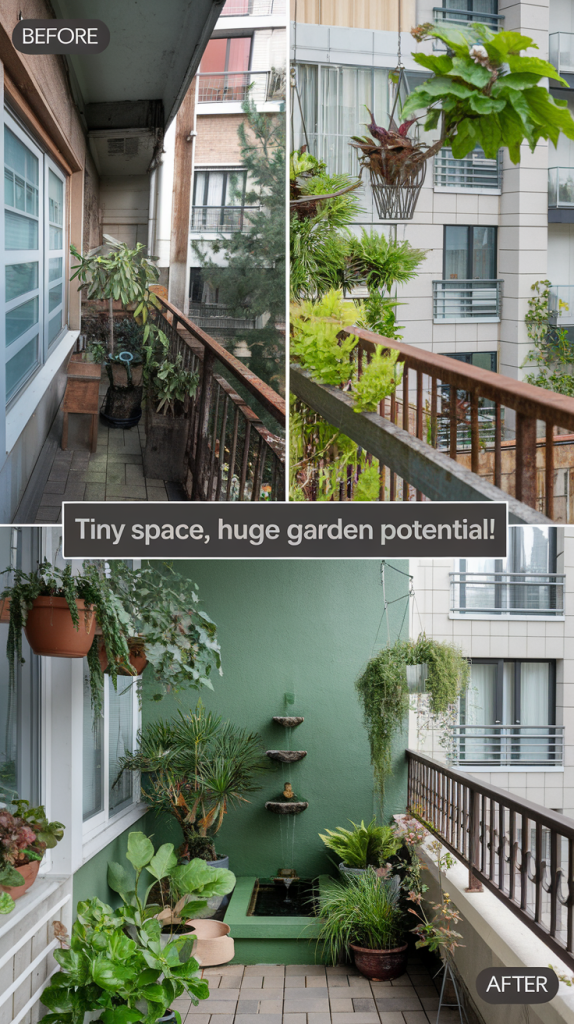
Small space gardens offer the advantage of simplified maintenance compared to larger landscapes, but they do require regular, focused attention. Establishing efficient care routines ensures your compact garden thrives with minimal time investment.
Implement a quick daily check-in routine during the growing season. Just two minutes each morning to observe your plants while enjoying coffee can catch potential issues before they become problems. This brief inspection allows you to spot pest activity, water needs, or harvesting opportunities that might otherwise be missed until damage occurs.
Prune proactively to maintain appropriate scale. Container plants can quickly outgrow their allocated space without regular maintenance. Pinching herbs encourages bushier growth, while removing lower leaves from tomatoes improves air circulation in dense plantings. These small, regular interventions prevent the need for drastic cutting later.
Fertilize strategically in smaller amounts but more frequently than in-ground gardens. Container soil has limited nutrients that deplete quickly, particularly with frequent watering. Diluted liquid organic fertilizer applied weekly during the growing season provides consistent nutrition without the feast-or-famine cycle that can stress plants in confined spaces.
Simplify seasonal transitions with a container renewal process. Rather than completely replacing soil each season, remove the top third of container soil and replace with fresh compost-enriched mix. This approach rejuvenates the growing medium while maintaining beneficial soil biology and saving both money and heavy lifting.
Picture this: Your Saturday morning maintenance routine taking just 20 minutes—deadheading spent flowers while harvesting a handful of lettuce for lunch, followed by a quick diluted fertilizer application and strategic pruning of a too-enthusiastic mint plant. This efficient approach maintains garden health without becoming a time-consuming chore, allowing you to enjoy the fruits of your labor rather than being burdened by them.
Discover time-saving garden tools specifically designed for container garden maintenance.
Whether you’re nurturing herbs outside a city apartment, growing salad greens on a suburban patio, or cultivating edible flowers on a tiny balcony, small space gardening offers outsized rewards for minimal investment. The practices we’ve explored—vertical growing, creative containers, space-efficient varieties, and thoughtful layout—transform limited square footage into thriving green sanctuaries that nourish both body and spirit.
Perhaps the greatest gift of small space gardening is its accessibility. Without requiring extensive knowledge, expensive equipment, or perfect conditions, these compact growing approaches invite experimentation and growth—both for plants and gardeners. Each container becomes a miniature laboratory where you can discover what thrives in your unique microclimate while developing confidence in your growing abilities.
As you implement these ideas in your own limited outdoor space, remember that garden development is a journey rather than a destination. Each season brings new insights, unexpected challenges, and delightful surprises. The vertical herb garden that begins as a few tentative plants may evolve into a lush green wall that transforms your morning tea ritual. The experimental tomato in a coconut shell container might become the starting point for an entire edible balcony that reduces your grocery bill while connecting you to seasonal rhythms.
What small corner of your world is waiting to be transformed? Which vertical surface could become your next growing area? How might your morning coffee taste when accompanied by herbs you’ve grown in repurposed containers just outside your door? Your garden journey begins with a single plant and expands with each small success—no vast landscape required.



